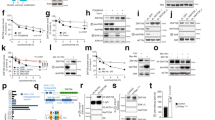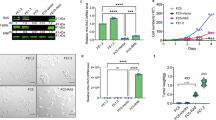Abstract
The hepatitis B virus HBx protein is a promiscuous transactivator implicated in the development of hepatocellular carcinoma. The ectopic expression of HBx fails to transform both primary and immortalized rodent cells, but rather induces apoptosis. Furthermore, most transgenic mice harboring HBx do not develop liver tumors. Thus, it remains unclear whether and how HBx contributes to oncogenesis. Here, we show that HBx collaborates with activated H-ras to transform immortalized rodent cells. Indeed, REF52 cells transfected by both HBx and activated H-ras were morphologically transformed and were able to grow in soft agar. Remarkably, nude mice injected with REF52 cells transfected by both HBx and activated H-ras developed tumors, whereas the mice injected with REF52 cells transfected by either gene alone did not. Thus, we concluded that HBx could contribute to neoplastic transformation of cells in collaboration with other oncogenes, such as H-ras, that renders cells to overcome the HBx-mediated apoptosis. Further, we found that HBx mediated apoptosis was suppressed by activated H-ras through activation of the phosphatidylinositol-3 kinase and Akt pathway. Data presented here firmly established the oncogenic potential of HBx during multistage carcinogenesis.
This is a preview of subscription content, access via your institution
Access options
Subscribe to this journal
Receive 50 print issues and online access
$259.00 per year
only $5.18 per issue
Buy this article
- Purchase on Springer Link
- Instant access to full article PDF
Prices may be subject to local taxes which are calculated during checkout




Similar content being viewed by others
References
Beasley RP, Hwang LY, Lin CC and Chien CS. . 1981 Lancet 2: 1129–1133.
Benn J and Schneider RJ. . 1994 Proc. Natl. Acad. Sci. USA 91: 10350–10354.
Benn J and Schneider RJ. . 1995 Proc. Natl. Acad. Sci. USA 92: 11215–11219.
Benn J, Su F, Doria M and Schneider RJ. . 1996 J. Virol. 70: 4978–4985.
Billet O, Grimber G, Levrero M, Seye KA, Briand P and Joulin V. . 1995 J. Virol. 69: 5912–5916.
Blum HE, Zhang ZS, Galun E, von Weizsacker F, Garner B, Liang TJ and Wands JR. . 1992 J. Virol. 66: 1223–1227.
Buendia MA. . 1992 Adv. Cancer Res. 59: 167–226.
Cardone MH, Roy N, Stennicke HR, Salvesen GS, Franke TF, Stanbridge E, Frisch S and Reed JC. . 1998 Science 282: 1318–1321.
Chen HS, Kaneko S, Girones R, Anderson RW, Hornbuckle WE, Tennant BC, Cote PJ, Gerin JL, Purcell RH and Miller RH. . 1993 J. Virol. 67: 1218–1226.
Cheong JH, Yi M, Lin Y and Murakami S. . 1995 EMBO J. 14: 143–150.
Chirillo P, Falco M, Puri PL, Artini M, Balsano C, Levrero M and Natoli G. . 1996 J. Virol. 70: 641–646.
Chirillo P, Pagano S, Natoli G, Puri PL, Burgio VL, Balsano C and Levrero M. . 1997 Proc. Natl. Acad. Sci. USA 94: 8162–8167.
Dandri M, Schirmacher P and Rogler CE. . 1996 J. Virol. 70: 5246–5254.
Datta K, Bellacosa A, Chan TO and Tsichlis PN. . 1996 J. Biol. Chem. 271: 30835–30839.
Datta SR, Dudek H, Tao X, Masters S, Fu H, Gotoh Y and Greenberg ME. . 1997 Cell 91: 231–241.
Doria M, Klein N, Lucito R and Schneider RJ. . 1995 EMBO J. 14: 4747–4757.
Franza BR, Maruyama K, Garrels JI and Ruley HE. . 1986 Cell 44: 409–418.
Ganem D and Varmus HE. . 1987 Annu. Rev. Biochem. 56: 651–693.
Guidotti LG, Matzke B, Schaller H and Chisari FV. . 1995 J. Virol. 69: 6158–6169.
Haviv I, Shamay M, Doitsh G and Shaul Y. . 1998 Mol. Cell. Biol. 18: 1562–1569.
Hockenbery D, Nunez G, Milliman C, Schreiber RD and Korsmeyer SJ. . 1990 Nature 348: 334–336.
Hohne M, Schaefer S, Seifer M, Feitelson MA, Paul D and Gerlich WH. . 1990 EMBO J. 9: 1137–1145.
Kauffmann-Zeh A, Rodriguez-Viciana P, Ulrich E, Gilbert C, Coffer P, Downward J and Evan G. . 1997 Nature 385: 544–548.
Kim CM, Koike K, Saito I, Miyamura T and Jay G. . 1991 Nature 351: 317–320.
Kim H, Lee H and Yun Y. . 1998 J. Biol. Chem. 273: 381–385.
Klein NP and Schneider RJ. . 1997 Mol. Cell. Biol. 17: 6427–6436.
Kohl NE and Ruley HE. . 1987 Oncogene 2: 41–48.
Koike K, Moriya K, Iino S, Yotsuyanagi H, Endo Y, Miyamura T and Kurokawa K. . 1994a Hepatology 19: 810–819.
Koike K, Moriya K, Yotsuyanagi H, Iino S and Kurokawa K. . 1994b J. Clin. Invest. 94: 44–49.
Land H, Parada LF and Weinberg RA. . 1983 Nature 304: 596–602.
Lee TH, Finegold MJ, Shen RF, DeMayo JL, Woo SL and Butel JS. . 1990 J. Virol. 64: 5939–5947.
Lee YH and Yun Y. . 1998 J. Biol. Chem. 273: 25510–25515.
Lin HJ, Eviner V, Prendergast GC and White E. . 1995 Mol. Cell. Biol. 15: 4536–4544.
Lucito R and Schneider RJ. . 1992 J. Virol. 66: 983–991.
Maguire HF, Hoeffler JP and Siddiqui A. . 1991 Science 252: 842–844.
Miura M, Zhu H, Rotello R, Hartwieg EA and Yuan J. . 1993 Cell 75: 653–660.
Natoli G, Avantaggiati ML, Chirillo P, Puri PL, Ianni A, Balsano C and Levrero M. . 1994 Oncogene 9: 2837–2843.
Oguey D, Dumenco LL, Pierce RH and Fausto N. . 1996 Hepatology 24: 1024–1033.
Paterlini P, Poussin K, Kew M, Franco D and Brechot C. . 1995 Hepatology 21: 313–321.
Qadri I, Conaway JW, Conaway RC, Schaack J and Siddiqui A. . 1996 Proc. Natl. Acad. Sci. USA 93: 10578–10583.
Schuster R, Gerlich WH and Schaefer S. . 2000 Oncogene 19: 1173–1180.
Serrano M, Lin AW, McCurrach ME, Beach D and Lowe SW. . 1997 Cell 88: 593–602.
Shirakata Y, Kawada M, Fujiki Y, Sano H, Oda M, Yaginuma K, Kobayashi M and Koike K. . 1989 Jpn. J. Cancer Res. 80: 617–621.
Spandau DF and Lee CH. . 1988 J. Virol. 62: 427–434.
Su F and Schneider RJ. . 1996 J. Virol. 70: 4558–4566.
Su F and Schneider RJ. . 1997 Proc. Natl. Acad. Sci. USA 94: 8744–8749.
Su Q, Schroder CH, Hofmann WJ, Otto G, Pichlmayr R and Bannasch P. . 1998 Hepatology 27: 1109–1120.
Tarn C, Bilodeau ML, Hullinger RL and Andrisani OM. . 1999 J. Biol. Chem. 274: 2327–2336.
Terradillos O, Billet O, Renard CA, Levy R, Molina T, Briand P and Buendia MA. . 1997 Oncogene 14: 395–404.
Terradillos O, Pollicino T, Lecoeur H, Tripodi M, Gougeon ML, Tiollais P and Buendia MA. . 1998 Oncogene 17: 2115–2123.
Williams JS and Andrisani OM. . 1995 Proc. Natl. Acad. Sci. USA 92: 3819–3823.
Yen TSB. . 1996 J. Biomed. Sci. 3: 20–30.
Zoulim F, Saputelli J and Seeger C. . 1994 J. Virol. 68: 2026–2030.
Acknowledgements
We thank H-S Cho for anti-HBx peptide antibody; CH Lee for pSV-X, RA Weinberg for pEJ 6.6(H-ras); B-S Yang for pRSV-myc; DS Im for pE1a(13S); J-K Jung for pcDNA-Akt-dn; Y-J Oh for pCMV-Bcl-2. We thank Drs Bill Mason, Jeff Glenn, B-S Yang and Y Yun for critical reading of the manuscript. This study was supported in part by research grants from the Molecular Medicine Project of the Ministry of Science and Technology, Republic of Korea.
Author information
Authors and Affiliations
Rights and permissions
About this article
Cite this article
Kim, Y., Song, KS., Yoon, G. et al. Activated ras oncogene collaborates with HBx gene of hepatitis B virus to transform cells by suppressing HBx-mediated apoptosis. Oncogene 20, 16–23 (2001). https://doi.org/10.1038/sj.onc.1203840
Received:
Revised:
Accepted:
Published:
Issue Date:
DOI: https://doi.org/10.1038/sj.onc.1203840
Keywords
This article is cited by
-
Hepatitis B virus X protein enhances Myc stability by inhibiting SCFSkp2 ubiquitin E3 ligase-mediated Myc ubiquitination and contributes to oncogenesis
Oncogene (2016)
-
Hepatitis B virus X protein accelerates hepatocarcinogenesis with partner survivin through modulating miR-520b and HBXIP
Molecular Cancer (2014)
-
Synergistic function of Kras mutation and HBx in initiation and progression of hepatocellular carcinoma in mice
Oncogene (2014)
-
Tackling hepatitis B virus-associated hepatocellular carcinoma—the future is now
Cancer and Metastasis Reviews (2013)
-
Hepatitis B Virus: A Molecular Perspective
Proceedings of the National Academy of Sciences, India Section B: Biological Sciences (2012)



